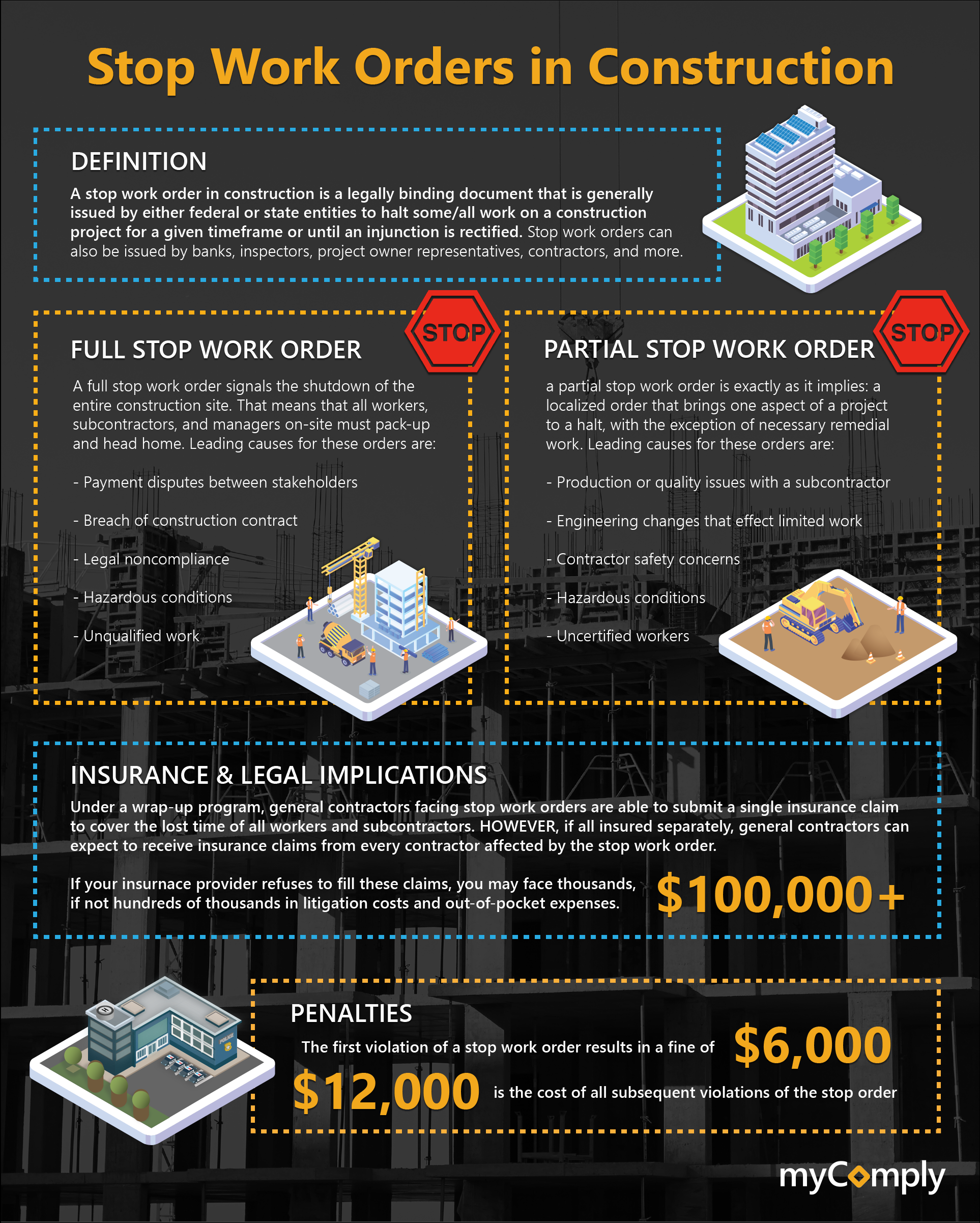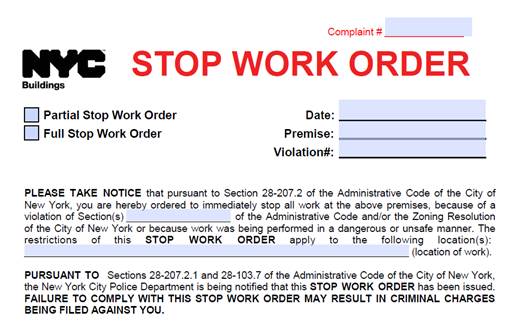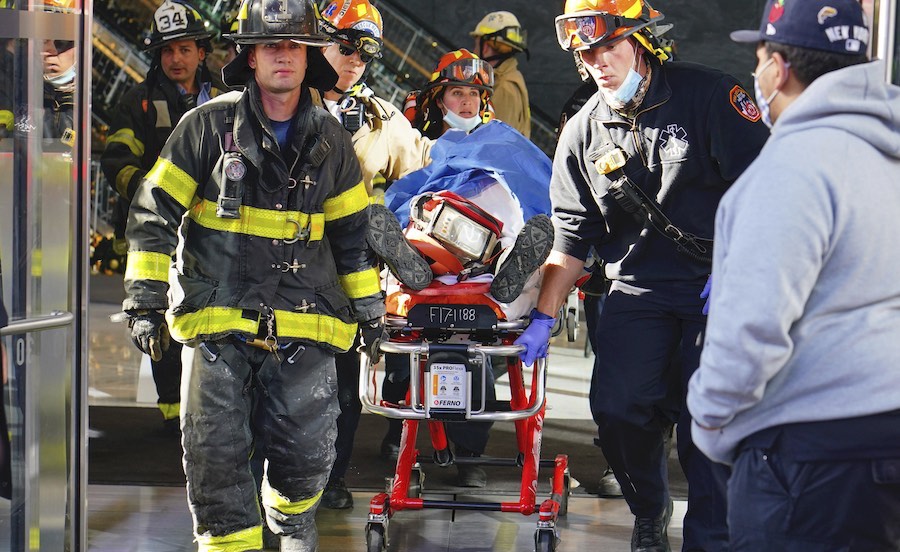Picture this: you wake up, get ready for work, commute over an hour to the construction project that your company is general contracting on, and you see a stop work order posted on the bulletin outside the project…
If you have ever experienced this, then you know just how frustrating and costly stop work orders can be. If not, then you are one of the lucky ones. However, no general contractor or subcontractor is immune to stop work orders. Asset owners, federal agents, and state/municipal inspectors are just a few of the parties that often have the authority to conduct random site inspections; and all it takes is one safety or regulatory violation to grind your project to a screeching halt.
With razor-thin margins and impossible project timelines, general contractors can’t afford any interruptions to their work. This article explores the nuances of stop work orders, provides an example, details on how a stop order works, a return on investment (ROI) impact analysis, and steps you can take to mitigate the risk of stop work orders on your projects.
Table of Contents
What is a Stop Work Order in Construction?
Full Stop Work Orders
Partial Stop Work Orders
Stop Work Order Example
How Does a Stop Order Work?
1. The Essential Components of a Stop Work Order
2. Recipient Responsibilities
3. Insurance Implications
Stop Work Orders: Extenuating Circumstances
1. Stop Work Orders in Construction Contracts
2. Stop Work Orders and the Federal Acquisition Regulation (FAR)
3. Stop Work Orders for State and Municipal Construction
Stop Work Orders: The Impact on Construction ROI
Conclusion: Stop Work Order Prevention
What is a Stop Work Order in Construction?
A stop work order in construction is a legally binding document that is issued by either federal or state entities to halt some of or all work on a construction project for a given timeframe or until an injunction is rectified. Stop work orders can also be issued by banks, inspectors, project owner representatives, contractors, and more.
The provisions of a stop work order are utilized to minimize the risk of a breach of contract, mitigate payment disputes, prevent bodily harm to workers on-site, deal with unanticipated project conditions, or to address hazardous materials/behaviors.
There are two primary types of stop work orders that contractors are susceptible to. Read on to find out more about each type of stop work order, or download this stop work order infographic!

Full Stop Work Orders
As its name implies, a full stop work order signals the shutdown of the entire construction site. That means that all workers, subcontractors, and managers on-site must pack-up and head home. The only work that is allowed to continue under a full stop work order is whatever remedial tasks need to be completed to restore safe site operations and have the order lifted. Full stop work orders are issued to general contractors or construction managers and are incredibly detrimental to project timelines, margins, and productivity.
The leading causes of full stop work orders include:
- Legal noncompliance
- Failure to comply with workers compensation law
- Violations of the Occupational Safety and Health Act (OSHA)
- Breach of construction contract
- Unqualified work
- Unlicensed contracting
- Unqualified workers or workers with expired certifications
- Hazardous conditions
- Hazardous materials
- Unsafe working conditions
- Payment disputes between contractors, asset owners, and financiers
Partial Stop Work Orders
Like a full stop work order, a partial stop work order is exactly as it implies: a localized order that brings one aspect of a project to a halt. Where full stop work orders are typically aimed at general contractors, partial stop work orders are more often the result of specific subcontractors conducting unsafe or noncompliant work. These orders prohibit a certain scope of work on the project, apart from remedial duties. Violations of these orders can result in additional fines and penalties.
Though partial stop work orders are less damaging than their “full” counterparts, they can still result in project delays if sequential work is unable to be completed on-schedule. Partial stop work orders can also be used by general contractors or asset owners as a tool to halt subcontractor work if changes to the project plan have been made.
The leading causes of partial stop work orders include:
- Contractor-specific safety concerns
- Unlicensed or uncertified workers
- Engineering changes that only effect certain portions of project work
- Production or quality of work issues with a subcontractor
Stop Work Order Example
Here is stop work order example from the New York City (NYC) Department of Buildings:

Source: NYC Buildings Twitter
Some key attributes of this stop work order example include:
- Declaration of full/partial order
- Issue date
- Issue location
- A unique violation number
- Description of the violation based on governing law
Most stop work orders will also include contact information for the parties that the contractor must reach-out to in-order to begin remedial work.
How Does a Stop Order Work?
We’ve walked you through the nuances of full stop work orders and partial stop work orders, we gave you a stop work order example from the NYC Department of Buildings, but you still might be wondering “how does a stop order work?” Fortunately, you are in the right place.
1. The Essential Components of a Stop Work Order
Though the specifics of stop work orders can vary slightly depending on the issuer and the state-specific governance, there are the same essential items across both full and partial stop work orders. It is also important to note that all stop work orders must be formally agreed upon by both the issuing party and the receiving party.
The essential components of a stop work order include:
- A description of all the activities being suspended (and why)
- Clear directions for the contractor to follow in order to comply with the order, including pending material orders, scope of remedial work, permit/inspection requirements, and more
- Suggestions on how to best handle all affected parties through the flow of work, including communications to subcontractors, material suppliers, overhead cost-related concerns, site security, as well as demobilization, and remobilization (if relevant)
- Contact information for the issuer
2. Recipient Responsibilities
Once issued, the stop work order demands the immediate halt of all pursuant actions, regardless of whether there are present (and/or valid) grounds for dispute. Anything other than immediate action to stop work is exposure to additional liability and risk of additional fines or penalties. For example, in NYC, the penalty for failure to comply with a stop work order is $6,000 on the first offence, and $12,000 for all subsequent offences.
If you are the recipient of a stop work order, here is what you should do:
- Stop all specified activities as quickly and safely as possible
- Take any necessary actions to prevent any further workplace obstructions
- Contact your attorney to ensure that you are adhering by the provisions outlined in the order or if you believe the order may have been improperly issued by an inspector, owner, developer, or other stakeholder
- Open discussions with the issuing party to clarify scope, logistics, timelines, grounds for extension of the order, and how/when the order will be lifted
- Work through demobilization logistics and prepare for remobilization
- Schedule an inspection by the issuing authority to confirm that the necessary actions have been taken to promote safety
- Remobilize your project work once remedial actions have been taken
- Be sure to document all actions taken, timeframes, and responses related to the stop work order
3. Insurance Implications
One of the most stressful components of the stop work order management process is dealing with insurance to cover both your own losses, as well as the losses of each subcontractor on the job. This process differs depending on whether you are insured under a wrap-up program or a traditional model, where each subcontractor is self-insured.
In the event of a stop work order, wrap-up insurance is the ideal coverage, as you simply submit a single claim to cover the lost time of all your workers and subcontractors. However, if you are insured separately, you can expect to receive insurance claims from every subcontractor that is affected by the stop work order. If your insurance provider is unwilling to fill these claims, you can face thousands, if not hundreds of thousands, or even millions in litigations costs and out-of-pocket expenses.
Stop Work Orders: Extenuating Circumstances
We have covered how a full/partial stop work order is issued and handled by the receiving party. However, there are extenuating circumstances that further complicate the stop work order process. Read on to find out more information pertaining to contractual and governmental regulation.
1. Stop Work Orders in Construction Contracts
Federal authorities such as Occupational Safety and Health Administration (OSHA) officers have jurisdiction over all construction sites and can issue stop work orders anywhere, anytime. State authorities such as NYC Department of Buildings officers have similar power over all construction sites operating within their territory. Asset owners, however, only have the power to issue a stop work order to contractors on their projects if those terms were clarified within the construction contract.
The construction contract is the formal agreement between the project owner and the prime contractor (or construction manager) that is overseeing the project work. If the owner wishes to have stopping power over the contractor, a “Stop Work Order Clause” should be included in the contract. This gives the owner, or an agent of the owner, the authority needed to issue a stop work order.
If a stop work order clause is not included in your contract and the asset owner issues one, you may have grounds for legal action if you so choose.
2. Stop Work Orders and the Federal Acquisition Regulation (FAR)
The FAR outlines the rules that govern the procurement of federal projects in the United States. More specifically, federal work contracts use the FAR to preside over goods and services acquisitions, including construction. Under the FAR, lies the “FAR Stop-Work Order Clause,” which states that:
“The Contracting Officer may, at any time, by written order to the Contractor, require the Contractor to stop all, or any part, of the work called for by this contract for a period of 90 days after the order is delivered to the Contractor, and for any further period to which the parties may agree.
The order shall be specifically identified as a stop-work order issued under this clause. Upon receipt of the order, the Contractor shall immediately comply with its terms and take all reasonable steps to minimize the incurrence of costs allocable to the work covered by the order during the period of work stoppage.”
In other words, stop work orders can be issued at by a governmental agent at any time on federal projects.
3. Stop Work Orders for State and Municipal Construction
Contracting on a public works project does not mean that your immune to stop work orders. In fact, most state and municipal governments have provisions for issuing stop work orders on public work projects as well. The NYC Department of Buildings is a great example of a governing authority that can inspect, and issue, stop work orders on both public and private projects.
Like other authorities, most state and municipal bodies are looking for any work that violates construction codes, zoning agreements, governing law, or any blatantly unsafe activities on a jobsite.
Stop Work Orders: The Impact on Construction ROI
As implied, one of the greatest threats stemming from the issuance of a stop work order is the impact on project ROI. So, what is the risk of receiving a stop work order on your project? Higher than you might think.
Some states and municipalities, such as New York City (NYC), have been taking aim at construction safety by performing “zero tolerance” safety sweeps on construction sites. Following seven fatalities in the first half of 2021, NYC Buildings Commissioner, Melanie E. La Rocca, launched a three-month campaign to promote enhanced safety across the city. The result?
Stats from New York City’s “zero tolerance” construction safety initiative:
- 7,500 construction sites inspected
- 3,600 safety violations issued, resulting in fines
- 1,499 stop work orders
Here is an image captured following a scaffolding collapse in Hudson’s Yard:

Source: Engineering News-Record
Inspectors were busy, visiting nearly every site across the five boroughs, but the reality is that inspectors cannot be everywhere, all the time.
“To protect the lives of the working men and women who are building in our city, we need our partners in the construction industry to step up and join us in pushing for enhanced round-the-clock supervision and greater accountability.”
It’s obvious that protecting the health and wellbeing of all construction workers is of paramount importance. However, unsafe behaviors, hazardous materials, unqualified workers, and other obstructions that lead to construction site violations, also have major repercussions for the general contractors and asset owners that manage these projects.
Let’s break it down:
| Contract value of project | $100 million |
| Estimated completion time | 5 years |
| Contractor value, per day | $100 million / (365 x 5) = $54,794/day |
| Average stop work order length | 90 days |
| Cost of stop work order | $4,931,460 |
As you can see, stop work orders can lead to massive financial shortfalls for contractors if not handled swiftly or (better yet), prevented in the first place.
Interested in learning other tactics to help boost your profit margins on projects? Read 4 Tactics to Increase Mega Construction Profit Margins.
Conclusion: Stop Work Order Prevention
The best way to prevent stop work orders from hindering progress on your sites is by implementing proactive measures aimed at minimizing the risk of noncompliance, unsafe work, unqualified work, or payment disputes.
Though some measures may be procedural, the effectiveness of proactive safety measures are greatly enhanced when paired with construction technology solutions.
myComply is one of the leading proactive safety solutions available to contractors in the construction space. Here is how the myComply platform positions general contractors to mitigate the risk of stop work orders on their projects:
- Certification tracking. When you use myComply, your team can set certification or qualification requirements for each worker, under each subcontractor. Your subcontractors are then required to upload proof of certifications as well as expiration dates, to ensure that only qualified workers will be conducting work on your project site. Being that unlicensed/uncertified workers are one of the leading causes of stop work orders, you can rest assured knowing that you are protected.
- Access control. Operating in a busy urban setting? myComply works best when integrated with existing access control hardware, such as door strikes and turnstiles. This allows contractors to automatically document when each worker enters the project site, when they leave, and when their certifications expire.
Interested in finding out more? Book a demo with one of our product experts to determine whether there is a fit for myComply on your next project.



